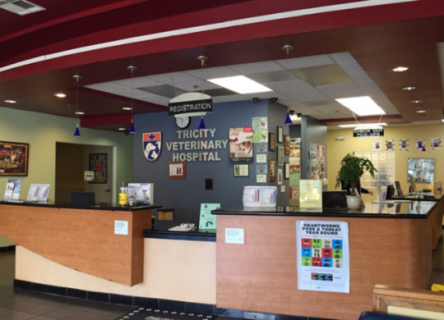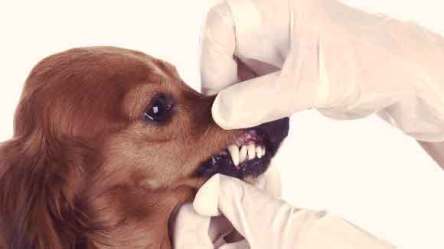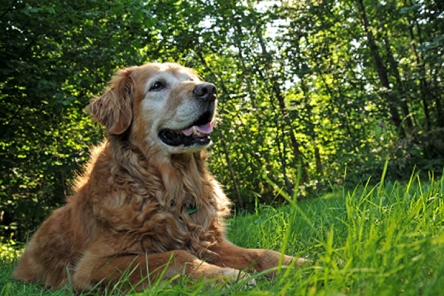
Beyond first rate pet care, we make our clinic a comfortable, kid-friendly, and very calm environment so that your pet can relax in the waiting room and look forward to meeting his or her own Fremont veterinarian.

Beyond first rate pet care, we make our clinic a comfortable, kid-friendly, and very calm environment so that your pet can relax in the waiting room and look forward to meeting his or her own Fremont veterinarian.
Located in Fremont, California TriCity Veterinary Hospital is a full-service veterinary clinic providing compassionate care to pets within a friendly and modern facility.

While your veterinarian’s four senses are good at helping detect a number of health issues, laboratory testing allows us to evaluate the function of internal organs, blood, and other systems. These tests are critical for uncovering underlying disease processes that otherwise would remain unnoticed until they cause serious symptoms in your pet.


An average dog should have a diet that is 50% vegetable, 40% meat and 10% grain. Grown dogs need a minimum of 18% protein on a dry matter basis, whereas puppies require at least 22%. All dogs also require some fat, amount dependent on their level of activity. Dogs also need approximately 4% of their diets to be fiber. These are all, again, on average. In doing a dog food comparison, it is best to start with the labels.
Dog Food Ingredients: A good way to determine the quality of a food is the ingredient list. With a little practice, you can find a food that does not have unwanted products and is highly digestible. The ingredients are listed in order by weight.
One trick some manufacturers use is to break an ingredient into several different smaller ingredients and list them separately. For example, the ingredients might include chicken (first), ground corn, corn gluten, and corn bran (further down). You might think chicken is the main ingredient but, grouping the corn ingredients together, they would likely greatly outweigh the amount of chicken.
The following must be included on dog food labels:
Note: “Crude” does not take into account digestibility or the source. The source could be human-grade beef or chicken feathers.
Luckily, healthy dog foods are easy to find today. Or, you can try making your own food with healthy dog food recipes. If you choose to do this, consult with your vet and do some research. There is a lot of information online and in books such as “The Whole Pet Diet.” Some things to consider for buying or making are:
Healthy nutrition is the foundation but don’t forget the other elements of a healthy canine lifestyle: exercise, medical check-ups, alternative medicine such as Acupuncture, dental hygiene, and grooming. Manage all of these and you will have one happy, healthy dog.
We also strongly believe that client education and communication are vital aspects of good veterinary care.

Infections, ear mites, low-grade allergies and other related health issues are relatively common in companion animals. It is relatively easy for your veterinarian to take a look inside the ears to see if there are any indications of ear disease.

Ocular conditions such as glaucoma are relatively common in older pets and, as with other vision-related issues, can be well treated when discovered early.

There are a number of health issues that can be detected by listening to your pet’s lungs.
/about/DogCardiosb10063336m-001-56a9c1ef5f9b58b7d0febc79.jpg)
Just as any other member of your family sees a physician for routine physicals, your pet needs to see his or her veterinarian in order to check for underlying signs of ill-health.


As your dog ages, many of his basic needs, from diet to exercise, will begin to change. This guide will help you understand what it takes to keep your senior dog happy and healthy.
Dogs are very good at hiding their health problems and as an owner, it’s your responsibility to keep an eye on your senior dog to ensure that you are adjusting his routine to match changes in his body and immune system that make him less able to cope with physical and environmental stresses. Routine exams, preventive medicine and adjustments to your dog’s lifestyle can help your pooch stay healthy even as the years creep up.
Different sized dogs age at varying rates, with larger dogs reaching senior status much sooner than smaller dogs.
While each dog reaches “seniorhood” at a different age, most canines become seniors between 7 and 10 years old. It’s important to know your dog’s age, so you know when he becomes a senior. Ask your vet about when your dog’s needs may begin to change.
You and your vet will begin looking for specific issues that become more prevalent as a dog ages. Here’s a list of some of these issues:
Just as with people, regular health checkups become increasingly important as dogs grow older. Most experts agree that senior dogs should be seen at least once every six months. The purpose of these wellness exams is to do three things:
During a typical wellness exam, your vet will ask a variety of health-related questions in order to build a snapshot of your dog’s medical history. These questions often focus on your pup’s regular behaviors and whether you’ve observed any recent changes that may indicate a developing health concern.
During this checkup, vets typically check a dog’s body for tumors, signs of pain, or arthritis. In addition, your vet will assess your dog’s overall appearance and body condition, scanning his eyes, ears, nose, and mouth for irregularities as well as listening to his lungs and heart. A routine checkup may also include the following battery of diagnostic tests.
Most veterinarians agree that these baseline laboratory tests should be performed at least once a year in adult dogs ages two to seven years old, and more frequently in senior dogs. These baseline screenings allow your vet to monitor any developing trends in your dog’s health status as it changes from year to year. Additional testing may be necessary if your dog has any ongoing health issues, or if these routine screenings uncover any unusual results.
Many of the illnesses that commonly plague senior dogs are obvious even to the untrained eye. So it’s important that you monitor changes in your dog’s health between regular vet visits. If any of the following signs present themselves, contact your vet immediately.
Unexplained fluctuations in your dog’s weight may be an early sign of an underlying disease. Weight management itself can be a huge factor in your dog’s health. Obesity in dogs increases the risk of developing arthritis and a number of other diseases.
Along with being more watchful over your senior dog’s health, it’s crucial that you keep up with routine preventive care such as parasite prevention, dental care, vaccinations, and nutritional management. As your dog’s immune system weakens, the importance of routine basic care only increases.
Create a comfortable environment for your aging best friend with easy access to food, supportive bedding, and fresh water whenever he needs it. In addition, plenty of regular attention and affection is good for morale, both yours and your senior dog’s.
Foods designed for senior dogs often have less fat, but not lower protein levels. Ask your vet to recommend a senior dog food formula for your dog. Size typically determines the age at which you should shift your dog to a senior-friendly diet:
Smaller, more frequent meals are often easier on a senior dog’s digestive system. You may also want to adjust your bathroom routine, giving your dog more frequent opportunities to go outside.
Older dogs can’t regulate their body temperature as well as they could in their younger days. It is important to keep your dog warm, dry, and indoors when he’s not out getting his exercise. Senior canines are also more sensitive to heat and humidity, so protect them from conditions in which they may overheat.
If your dog has arthritis, he may prefer a ramp instead of walking up the stairs, extra blankets on his bed, or even a new bed designed to promote orthopedic health. If your dog suffers from vision loss, it’s a good idea to ease his anxiety by keeping floors clear of clutter. These little things add up.
Plaque and tartar buildup can lead to a number of nasty health problems for your dog. Regular brushing with a specially formulated canine toothpaste can reduce the likelihood of any problems. Discuss with your vet whether your dog should come into the office for a thorough cleaning.